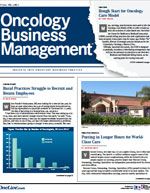ASCO Says Its Revised Value Model Is More Practical
ASCO's value framework tool for scoring drugs evaluated in trials has been upgraded to address more than 400 comments—mainly, responses to a survey—made by physicians and others.
Lowell E. Schnipper, MD,
lead study author
ASCO’s value framework tool for scoring drugs evaluated in trials has been upgraded to address more than 400 comments—mainly, responses to a survey—made by physicians and others. The improved framework, announced just before the 2016 ASCO Annual Meeting, will eventually become the basis for a software tool that physicians can use to enhance shared decision making with their patients, ASCO said.
The revisions to the value framework include a Net Health Benefits (NHB) score that does a better job of reflecting the true differences between treatments. For example, the framework now uses hazard ratios (HRs, instead of absolute survival measures, to provide a more complete assessment of the relative differences between therapies. The framework also recognizes treatments that improve long-term disease control for a significant portion of patients. The task force said doctors will need to explain treatment longevity benefits in absolute terms in order to avoid “the misinterpretation that a favorable HR necessarily represents a large absolute gain in overall survival or progression-free survival.”
The task force defended its NHB score, both before and after the revision, as a means of addressing the concerns that are foremost in patients’ minds. “The NHB score was perceived by some readers as arbitrary, not intuitive, and therefore lacking the meaning that an absolute value for either clinical benefit or toxicity would have,” the task force wrote. However, it also said the NHB score incorporates the very elements of treatment that patients seek to understand in order to reach their own decisions about care. Two versions of the framework have been created: one for advanced disease and the other for potentially curable (adjuvant therapy) clinical presentations.
In response to criticism that the previous framework didn’t incorporate the multitude of nonprescription costs into its therapy scoring mechanism, the task force said that such cost data are not “easily quantified for any given group of patients” and are better handled as part of the patient—physician discussion. “By discussing several alternative regimens, a patient can judge the clinical benefit he or she might derive and at what cost, both physically and financially. This should facilitate the generation of a sound, personalized treatment plan that takes into account goals of care and financial realities.”
Some of those who commented on the previous model wondered whether the value framework was intended to drive public policy discussions about drug pricing. The task force said that was not one of the goals, but said, “The task force fully acknowledges that value assessments supported by such a framework could be generated for use in the development of health care policy. Such an adaptation of the original intent of the framework would require further discussion with physicians, health economists, and key stakeholder groups, including patients, the pharmaceutical industry, and payers.”
In addition, the task force sought to allay concerns that “judgements about the value of specific drugs or regimens would be made using a one-size-fits-all set of assumptions.” The framework is intended to work differently, the task force members said. “The categories that are scored (ie, clinical benefit and toxicity) will be subject to weighting by the individual patient, so each person can determine the extent to which he or she wishes to emphasize length of survival over avoidance of adverse effects, or the reverse. If a patient values avoidance of toxicity over length of life, as we know some with advanced cancer do, the software tool developed from the framework can be adjusted so that toxicity is given greater overall weight compared with OS.”
One of the changes to the NHB score is that it now takes into account all side effects, not just the most severe high-grade reactions. Patients had commented that even minor side effects can have a major impact on quality of life (QOL). Bonus points are now incorporated into the NHB score for improvements in QOL.
What remains unchanged is that ASCO’s value framework will continue to compare only drugs that were evaluated in the same trial, as that remains the “only scientifically valid way” to make such comparisons, ASCO said. However, the task force stated in its report on the update that cross-trial comparisons are desirable and that “such analyses are important to patients and remain a goal for future versions of the value framework.”2
Some suggested that the framework should incorporate patient reported outcomes (PROs), but ASCO said that isn’t yet possible because trials don’t adequately measure or report such data. “Much work is needed to develop reliable assessments and consistent use of PROs, both within clinical trials and as part of routine clinical care. Future versions of the framework will recognize these when they are evidence-based and thereby facilitate incorporation of PROs into the determination of the NHB of a treatment,” the task force report wrote.
Reference
Schnipper LE, Davidson NE, Wollins, DS, et al. Updating the American Society of Clinical Oncology value framework: revisions and reflections in response to comments received. J Clin Oncol. 2016. doi: 10.1200/JCO.2016.68.2518. Accessed June 8, 2016.
The initial version, introduced a year ago as a prototype for valuing drugs based on cost and efficacy, was viewed as inflexible and highly limited—as it could only compare drugs evaluated in the same trials—but also well worth pursuing, as the emphasis on value in cancer care is growing. The majority of those who commented on the framework “agreed with the need for a formal approach to define the value of cancer treatments and supported the development of a tool to facilitate one-on-one discussions with patients regarding the relative value of various treatment options,” wrote members of the task force who worked on the revisions.




